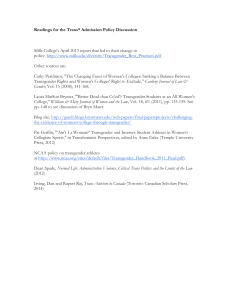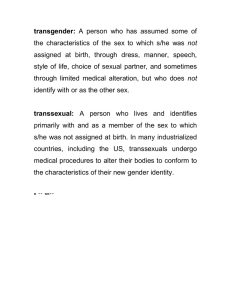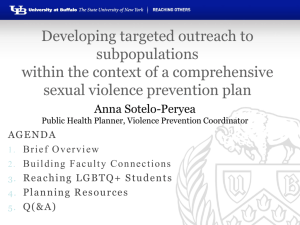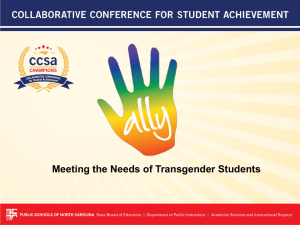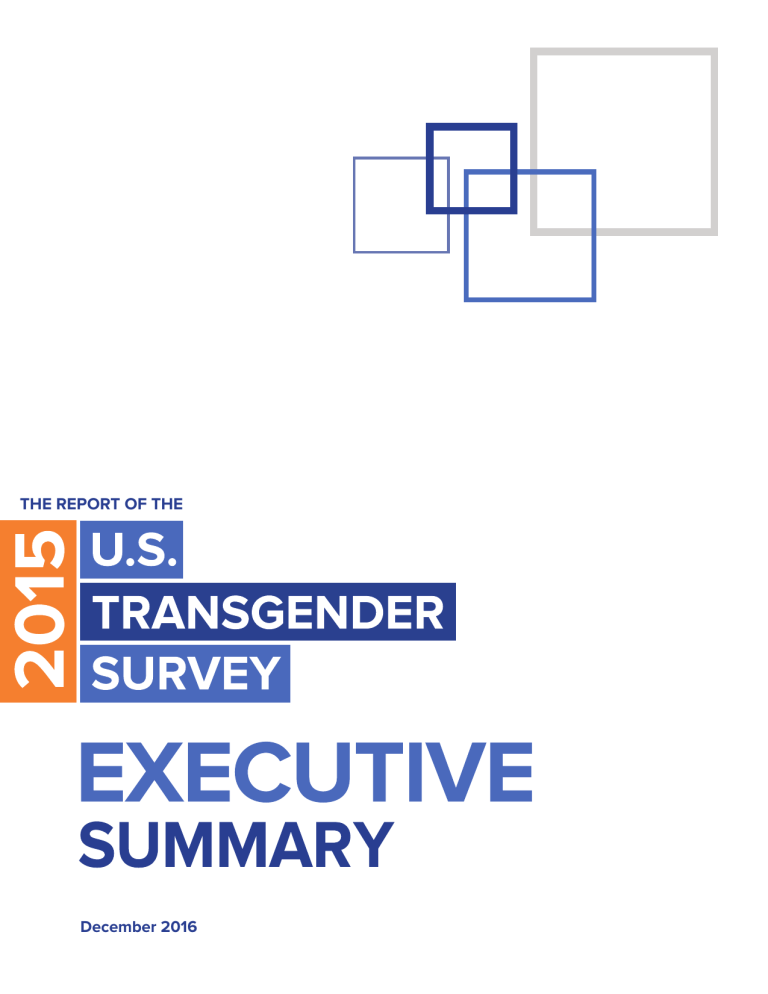
THE REPORT OF THE December 2016 USTS Executive Summary T he 2015 U.S. Transgender Survey (USTS) is the largest survey examining the experiences of transgender people in the United States, with 27,715 respondents from all fifty states, the District of Columbia, American Samoa, Guam, Puerto Rico, and U.S. military bases overseas. Conducted in the summer of 2015 by the National Center for Transgender Equality, the USTS was an anonymous, online survey for transgender adults (18 and older) in the United States, available in English and Spanish. The USTS serves as a follow-up to the groundbreaking 2008–09 National Transgender Discrimination Survey (NTDS), which helped to shift how the public and policymakers view the lives of transgender people and the challenges they face. The report of the 2015 USTS provides a detailed look at the experiences of transgender people across a wide range of categories, such as education, employment, family life, health, housing, and interactions with the criminal justice system. The findings reveal disturbing patterns of mistreatment and discrimination and startling disparities between transgender people in the survey and the U.S. population when it comes to the most basic elements of life, such as finding a job, having a place to live, accessing medical care, and enjoying the support of family and community. Survey respondents also experienced harassment and violence at alarmingly high rates. Several themes emerge from the thousands of data points presented in the full survey report. Pervasive Mistreatment and Violence 2015 U.S. TRANSGENDER SURVEY Respondents reported high levels of mistreatment, harassment, and violence in every aspect of life. One in ten (10%) of those who were out to their immediate family reported that a family member was violent towards them because they were transgender, and 8% were kicked out of the house because they were transgender. 2 The majority of respondents who were out or perceived as transgender while in school (K–12) experienced some form of mistreatment, including being verbally harassed (54%), physically attacked (24%), and sexually assaulted (13%) because they were transgender. Further, 17% experienced such severe mistreatment that they left a school as a result. In the year prior to completing the survey, 30% of respondents who had a job reported being fired, denied a promotion, or experiencing some other form of mistreatment in the workplace due to their gender identity or expression, such as being verbally harassed or physically or sexually assaulted at work. In the year prior to completing the survey, 46% of respondents were verbally harassed and 9% were physically attacked because of being transgender. During that same time period, 10% of respondents were sexually assaulted, and nearly half (47%) were sexually assaulted at some point in their lifetime. Severe Economic Hardship and Instability The findings show large economic disparities between transgender people in the survey and the U.S. population. Nearly one-third (29%) of respondents were living in poverty, compared to 14% in the U.S. population. A major contributor to the high rate of poverty is likely respondents’ 15% unemployment rate—three times higher than the unemployment rate in the U.S. population at the time of the survey (5%). Respondents were also far less likely to own a home, with only 16% of respondents reporting homeownership, compared to 63% of the U.S. population. Even more concerning, nearly one-third (30%) of respondents have experienced homelessness at some point in their lifetime, and 12% reported experiencing homelessness in the year prior to completing the survey because they were transgender. Harmful Effects on Physical and Mental Health The findings paint a troubling picture of the impact of stigma and discrimination on the health of many transgender people. A staggering 39% of respondents experienced serious psychological distress in the month prior to completing the survey, compared with only 5% of the U.S. population. Among the starkest findings is that 40% of respondents have attempted suicide in their lifetime—nearly nine times the attempted suicide rate in the U.S. population (4.6%). EXECUTIVE SUMMARY Respondents also encountered high levels of mistreatment when seeking health care. In the year prior to completing the survey, one-third (33%) of those who saw a health care provider had at least one negative experience related to being transgender, such as being verbally harassed or refused treatment because of their gender identity. Additionally, nearly one-quarter (23%) of respondents reported that they did not seek the health care they needed in the year prior to completing the survey due to fear of being mistreated as a transgender person, and 33% did not go to a health care provider when needed because they could not afford it. 3 The Compounding Impact of Other Forms of Discrimination When respondents’ experiences are examined by race and ethnicity, a clear and disturbing pattern is revealed: transgender people of color experience deeper and broader patterns of discrimination than white respondents and the U.S. population. While respondents in the USTS sample overall were more than twice as likely as the U.S. population to be living in poverty, people of color, including Latino/a (43%), American Indian (41%), multiracial (40%), and Black (38%) respondents, were up to three times as likely as the U.S. population (14%) to be living in poverty. The unemployment rate among transgender people of color (20%) was four times higher than the U.S. unemployment rate (5%). People of color also experienced greater health disparities. While 1.4% of all respondents were living with HIV— nearly five times the rate in the U.S. population (0.3%)—the rate among Black respondents (6.7%) was substantially higher, and the rate for Black transgender women was a staggering 19%. Undocumented respondents were also more likely to face severe economic hardship and violence than other respondents. In the year prior to completing the survey, nearly onequarter (24%) of undocumented respondents were physically attacked. Additionally, onehalf (50%) of undocumented respondents have experienced homelessness in their lifetime, and 68% have faced intimate partner violence. Respondents with disabilities also faced higher rates of economic instability and mistreatment. Nearly one-quarter (24%) were unemployed, and 45% were living in poverty. Transgender people with disabilities were more likely to be currently experiencing serious psychological distress (59%) and more likely to have attempted suicide in their lifetime (54%). They also reported higher rates of mistreatment by health care providers (42%). 2015 U.S. TRANSGENDER SURVEY Increased Visibility and Growing Acceptance 4 Despite the undeniable hardships faced by transgender people, respondents’ experiences also show some of the positive impacts of growing visibility and acceptance of transgender people in the United States. One such indication is that an unprecedented number—nearly 28,000—of transgender people completed the survey, more than four times the number of respondents in the 2008–09 NTDS. This number of transgender people who elevated their voices reflects the historic growth in visibility that the transgender community has seen in recent years. Additionally, this growing visibility has lifted up not only the voices of transgender men and women, but also people who are non-binary, which is a term that is often used to describe people whose gender identity is not exclusively male or female, including those who identify as no gender, as a gender other than male or female, or as more than one gender. With non-binary people making up over one-third of the sample, the need for advocacy that is inclusive of all identities in the transgender community is clearer than ever. Respondents’ experiences also suggest growing acceptance by family members, colleagues, classmates, and other people in their lives. More than half (60%) of respondents who were out to their immediate family reported that their family was supportive of them as a transgender person. More than two-thirds (68%) of those who were out to their coworkers reported that their coworkers were supportive. Of students who were out to their classmates, more than half (56%) reported that their classmates supported them as a transgender person. O verall, the report provides evidence of hardships and barriers faced by transgender people on a day-to-day basis. It portrays the challenges that transgender people must overcome and the complex systems that they are often forced to navigate in multiple areas of their lives in order to survive and thrive. Given this evidence, governmental and private institutions throughout the United States should address these disparities and ensure that transgender people are able to live fulfilling lives in an inclusive society. This includes eliminating barriers to quality, affordable health care, putting an end to discrimination in schools, the workplace, and other areas of public life, and creating systems of support at the municipal, state, and federal levels that meet the needs of transgender people and reduce the hardships they face. As the national conversation about transgender people continues to evolve, public education efforts to improve understanding and acceptance of transgender people are crucial. The rates of suicide attempts, poverty, unemployment, and violence must serve as an immediate call to action, and their reduction must be a priority. Despite policy improvements over the last several years, it is clear that there is still much work ahead to ensure that transgender people can live without fear of discrimination and violence. EXECUTIVE SUMMARY 5 Overview of Key Findings Family Life and Faith Communities • A majority of respondents (60%) who were out to the immediate family they grew up with said that their family was generally supportive of their transgender identity, while 18% said that their family was unsupportive, and 22% said that their family was neither supportive nor unsupportive. • Those who said that their immediate families were supportive were less likely to report a variety of negative experiences related to economic stability and health, such as experiencing homelessness, attempting suicide, or experiencing serious psychological distress. Negative experiences among those with supportive and unsupportive families 0% 10% 20% Experienced homelessness 30% 40% 60% 27% 45% 37% Attempted suicide Currently experiencing serious psychological distress 50% 54% 31% 50% % of respondents whose families were supportive 2015 U.S. TRANSGENDER SURVEY % of respondents whose families were unsupportive 6 • One in ten (10%) respondents who were out to their immediate family reported that a family member was violent towards them because they were transgender. • One in twelve (8%) respondents who were out to their immediate family were kicked out of the house, and one in ten (10%) ran away from home. • Nineteen percent (19%) of respondents who had ever been part of a spiritual or religious community left due to rejection. Forty-two percent (42%) of those who left later found a welcoming spiritual or religious community. Identity Documents • Only 11% of respondents reported that all of their IDs had the name and gender they preferred, while more than two-thirds (68%) reported that none of their IDs had the name and gender they preferred. Updated name or gender on ID OUT OF THOSE WHO HAD ID AND WANTED TO UPDATE IT (%) 0% 5% 10% 15% 20% 25% 40% 45% 50% 29% 43% Social Security records 23% 31% Student records (current or last school attended) 18% 28% Passport Updated name 35% 44% Driver’s license/ state-issued ID Birth certificate 30% 18% 18% 9% Updated gender • The cost of changing ID documents was one of the main barriers respondents faced, with 35% of those who have not changed their legal name and 32% of those who have not updated the gender on their IDs reporting that it was because they could not afford it. • Nearly one-third (32%) of respondents who have shown an ID with a name or gender that did not match their gender presentation were verbally harassed, denied benefits or service, asked to leave, or assaulted. EXECUTIVE SUMMARY 7 Health Insurance and Health Care • One in four (25%) respondents experienced a problem in the past year with their insurance related to being transgender, such as being denied coverage for care related to gender transition or being denied coverage for routine care because they were transgender. • More than half (55%) of those who sought coverage for transition-related surgery in the past year were denied, and 25% of those who sought coverage for hormones in the past year were denied. • One-third (33%) of those who saw a health care provider in the past year reported having at least one negative experience related to being transgender, such as being refused treatment, verbally harassed, or physically or sexually assaulted, or having to teach the provider about transgender people in order to get appropriate care, with higher rates for people of color and people with disabilities. • In the past year, 23% of respondents did not see a doctor when they needed to because of fear of being mistreated as a transgender person, and 33% did not see a doctor when needed because they could not afford it. Psychological Distress and Attempted Suicide • Thirty-nine percent (39%) of respondents experienced serious psychological distress in the month before completing the survey (based on the Kessler 6 Psychological Distress Scale), compared with only 5% of the U.S. population. • Forty percent (40%) have attempted suicide in their lifetime, nearly nine times the rate in the U.S. population (4.6%). • Seven percent (7%) attempted suicide in the past year—nearly twelve times the rate in the U.S. population (0.6%). HIV • Respondents were living with HIV (1.4%) at nearly five times the rate in the U.S. population (0.3%). • HIV rates were higher among transgender women (3.4%), especially transgender women of color. Nearly one in five (19%) Black transgender women were living with HIV, and American Indian (4.6%) and Latina (4.4%) women also reported higher rates. 8 Experiences in Schools • More than three-quarters (77%) of those who were out or perceived as transgender at some point between Kindergarten and Grade 12 (K–12) experienced some form of mistreatment, such as being verbally harassed, prohibited from dressing according to their gender identity, disciplined more harshly, or physically or sexually assaulted because people thought they were transgender. • Fifty-four percent (54%) of those who were out or perceived as transgender in K–12 were verbally harassed, nearly one-quarter (24%) were physically attacked, and 13% were sexually assaulted in K–12 because of being transgender. • Seventeen percent (17%) faced such severe mistreatment as a transgender person that they left a K–12 school. • Nearly one-quarter (24%) of people who were out or perceived as transgender in college or vocational school were verbally, physically, or sexually harassed. Experiences of people who were out as transgender in K–12 or believed classmates, teachers, or school staff thought they were transgender EXPERIENCES % OF THOSE WHO WERE OUT OR PERCEIVED AS TRANSGENDER Verbally harassed because people thought they were transgender 54% Not allowed to dress in a way that fit their gender identity or expression 52% Disciplined for fighting back against bullies 36% Physically attacked because people thought they were transgender 24% Believe they were disciplined more harshly because teachers or staff thought they were transgender 20% Left a school because the mistreatment was so bad 17% Sexually assaulted because people thought they were transgender 13% Expelled from school 6% One or more experiences listed 77% EXECUTIVE SUMMARY 9 Income and Employment Status • The unemployment rate among respondents (15%) was three times higher than the unemployment rate in the U.S. population (5%), with Middle Eastern, American Indian, multiracial, Latino/a, and Black respondents experiencing higher rates of unemployment. Unemployment rate RACE/ETHNICITY (%) 0% 5% Overall 10% 15% 5% American Indian Asian 20% 25% 10% 4% Black 20% 10% 21% 7% 35% Middle Eastern* Multiracial White 35% 23% 12% Latino/a 30% 15% 22% 9% 4% % in USTS (supplemental survey weight applied) 12% % in U.S. population (CPS) * U.S. population data for Middle Eastern people alone is unavailable in the CPS. • Nearly one-third (29%) were living in poverty, more than twice the rate in the U.S. population (14%). Employment and the Workplace 2015 U.S. TRANSGENDER SURVEY • One in six (16%) respondents who have ever been employed—or 13% of all respondents in the sample—reported losing a job because of their gender identity or expression in their lifetime. 10 • In the past year, 27% of those who held or applied for a job during that year—19% of all respondents—reported being fired, denied a promotion, or not being hired for a job they applied for because of their gender identity or expression. • Fifteen percent (15%) of respondents who had a job in the past year were verbally harassed, physically attacked, and/or sexually assaulted at work because of their gender identity or expression. • Nearly one-quarter (23%) of those who had a job in the past year reported other forms of mistreatment based on their gender identity or expression during that year, such as being forced to use a restroom that did not match their gender identity, being told to present in the wrong gender in order to keep their job, or having a boss or coworker share private information about their transgender status with others without their permission. • Overall, 30% of respondents who had a job in the past year reported being fired, denied a promotion, or experiencing some other form of mistreatment related to their gender identity or expression. • More than three-quarters (77%) of respondents who had a job in the past year took steps to avoid mistreatment in the workplace, such as hiding or delaying their gender transition or quitting their job. Housing, Homelessness, and Shelter Access • Nearly one-quarter (23%) of respondents experienced some form of housing discrimination in the past year, such as being evicted from their home or denied a home or apartment because of being transgender. • Nearly one-third (30%) of respondents have experienced homelessness at some point in their lives. • In the past year, one in eight (12%) respondents experienced homelessness because of being transgender. • More than one-quarter (26%) of those who experienced homelessness in the past year avoided staying in a shelter because they feared being mistreated as a transgender person. Those who did stay in a shelter reported high levels of mistreatment: seven out of ten (70%) respondents who stayed in a shelter in the past year reported some form of mistreatment, including being harassed, sexually or physically assaulted, or kicked out because of being transgender. Seven out of ten respondents who stayed in a shelter in the past year reported being mistreated because of being transgender. EXECUTIVE SUMMARY • Respondents were nearly four times less likely to own a home (16%) compared to the U.S. population (63%). 11 Sex Work and Other Underground Economy Work • Respondents reported high rates of experience in the underground economy, including sex work, drug sales, and other work that is currently criminalized. One in five (20%) have participated in the underground economy for income at some point in their lives— including 12% who have done sex work in exchange for income—and 9% did so in the past year, with higher rates among women of color. • Respondents who interacted with the police either while doing sex work or while the police mistakenly thought they were doing sex work reported high rates of police harassment, abuse, or mistreatment, with nearly nine out of ten (86%) reporting being harassed, attacked, sexually assaulted, or mistreated in some other way by police. • Those who have done income-based sex work were also more likely to have experienced violence. More than three-quarters (77%) have experienced intimate partner violence and 72% have been sexually assaulted, a substantially higher rate than the overall sample. Out of those who were working in the underground economy at the time they took the survey, nearly half (41%) were physically attacked in the past year and over one-third (36%) were sexually assaulted during that year. Police Interactions and Prisons • Respondents experienced high levels of mistreatment and harassment by police. In the past year, of respondents who interacted with police or law enforcement officers who thought or knew they were transgender, more than half (58%) experienced some form of mistreatment. This included being verbally harassed, repeatedly referred to as the wrong gender, physically assaulted, or sexually assaulted, including being forced by officers to engage in sexual activity to avoid arrest. 2015 U.S. TRANSGENDER SURVEY • Police frequently assumed that respondents—particularly transgender women of color— were sex workers. In the past year, of those who interacted with law enforcement officers who thought or knew they were transgender, one-third (33%) of Black transgender women and 30% of multiracial women said that an officer assumed they were sex workers. 12 • More than half (57%) of respondents said they would feel uncomfortable asking the police for help if they needed it. • Of those who were arrested in the past year (2%), nearly one-quarter (22%) believed they were arrested because they were transgender. Transgender women reporting that police assumed they were sex workers in the past year (out of those who interacted with officers who thought they were transgender) RACE/ETHNICITY (%) 0% Overall* 5% 10% 15% 20% 25% 30% 35% 11% American Indian women 23% Asian women 20% 33% Black women 25% Latina women Middle Eastern women** 30% Multiracial women White women 11% *Represents respondents of all genders who interacted with officers who thought they were transgender **Sample size too low to report • Respondents who were held in jail, prison, or juvenile detention in the past year faced high rates of physical and sexual assault by facility staff and other inmates. In the past year, nearly one-quarter (23%) were physically assaulted by staff or other inmates, and one in five (20%) were sexually assaulted. Respondents were over five times more likely to be sexually assaulted by facility staff than the U.S. population in jails and prisons, and over nine times more likely to be sexually assaulted by other inmates. Harassment and Violence • Nearly half (46%) of respondents were verbally harassed in the past year because of being transgender. • Nearly one in ten (9%) respondents were physically attacked in the past year because of being transgender. • Nearly half (47%) of respondents were sexually assaulted at some point in their lifetime and one in ten (10%) were sexually assaulted in the past year. Respondents who have done sex work (72%), those who have experienced homelessness (65%), and people with disabilities (61%) were more likely to have been sexually assaulted in their lifetime. • Nearly one-quarter (24%) have experienced severe physical violence by an intimate partner, compared to 18% in the U.S. population. EXECUTIVE SUMMARY • More than half (54%) experienced some form of intimate partner violence, including acts involving coercive control and physical harm. 13 Places of Public Accommodation • Respondents reported being denied equal treatment or service, verbally harassed, or physically attacked at many places of public accommodation—places that provide services to the public, like retail stores, hotels, and government offices. Out of respondents who visited a place of public accommodation where staff or employees thought or knew they were transgender, nearly one-third (31%) experienced at least one type of mistreatment in the past year in a place of public accommodation. This included 14% who were denied equal treatment or service, 24% who were verbally harassed, and 2% who were physically attacked because of being transgender. • One in five (20%) respondents did not use at least one type of public accommodation in the past year because they feared they would be mistreated as a transgender person. Denied equal treatment or service, verbally harassed, or physically attacked in public accommodations in the past year because of being transgender LOCATION VISITED % OF THOSE WHO SAID STAFF KNEW OR THOUGHT THEY WERE TRANSGENDER Public transportation 34% Retail store, restaurant, hotel, or theater 31% Drug or alcohol treatment program 22% Domestic violence shelter or program or rape crisis center 22% Gym or health club 18% Public assistance or government benefit office 17% Department of Motor Vehicles (DMV) 14% Nursing home or extended care facility 14% Court or courthouse 13% Social Security office 11% Legal services from an attorney, clinic, or legal professional 6% 2015 U.S. TRANSGENDER SURVEY Experiences in Restrooms 14 The survey data was collected before transgender people’s restroom use became the subject of increasingly intense and often harmful public scrutiny in the national media and legislatures around the country in 2016. Yet respondents reported facing frequent harassment and barriers when using restrooms at school, work, or in public places. • Nearly one in ten (9%) respondents reported that someone denied them access to a restroom in the past year. • In the past year, respondents reported being verbally harassed (12%), physically attacked (1%), or sexually assaulted (1%) when accessing a restroom. • More than half (59%) of respondents avoided using a public restroom in the past year because they were afraid of confrontations or other problems they might experience. • Nearly one-third (32%) of respondents limited the amount that they ate and drank to avoid using the restroom in the past year. • Eight percent (8%) reported having a urinary tract infection, kidney infection, or another kidney-related problem in the past year as a result of avoiding restrooms. More than half (59%) of respondents avoided using a public restroom in the past year because they were afraid of confrontations or other problems they might experience. Civic Participation and Party Affiliation • More than three-quarters (76%) of U.S. citizens of voting age in the sample reported that they were registered to vote in the November 2014 midterm election, compared to 65% in the U.S. population. • More than half (54%) of U.S. citizens of voting age reported that they had voted in the midterm election, compared to 42% in the U.S. population. • Half (50%) of respondents identified as Democrats, 48% identified as Independents, and 2% identified as Republicans, compared to 27%, 43%, and 27% in the U.S. population, respectively. Political party affiliation % IN USTS % IN U.S. POPULATION (GALLUP) Democrat 50% 27% Independent 48% 43% 2% 27% POLITICAL PARTY Republican EXECUTIVE SUMMARY 15 About the National Center for Transgender Equality The National Center for Transgender Equality (NCTE) is the nation’s leading social justice policy advocacy organization devoted to ending discrimination and violence against transgender people. NCTE was founded in 2003 by transgender activists who recognized the urgent need for policy change to advance transgender equality. NCTE now has an extensive record winning life-saving changes for transgender people. NCTE works by educating the public and by influencing local, state, and federal policymakers to change policies and laws to improve the lives of transgender people. By empowering transgender people and our allies, NCTE creates a strong and clear voice for transgender equality in our nation’s capital and around the country. © 2016 The National Center for Transgender Equality. We encourage and grant permission for the reproduction and distribution of this publication in whole or in part, provided that it is done so with attribution to the National Center for Transgender Equality. Further written permission is not required. RECOMMENDED CITATION James, S. E., Herman, J. L., Rankin, S., Keisling, M., Mottet, L., & Anafi, M. (2016). Executive Summary of the Report of the 2015 U.S. Transgender Survey. Washington, DC: National Center for Transgender Equality. The full report of the 2015 U.S. Transgender Survey is available at www.USTransSurvey.org. 1400 16th St. N.W., Suite 510, Washington, D.C. 20036 202-642-4542 | ncte@transequality.org ustranssurvey.org | transequality.org
